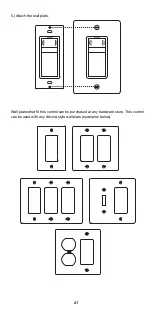
24
enclosure, even the very small ones. Seal every opening and around electrical
wires at their entering point. Also seal the perimeter around the enclosure between
the wall board and the enclosure. This will stop heat loss and allow this CONTROL
to sense the room and not the drafts in the walls.
around edges
punch-outs
wire access
vent grooves
(Example)
Wall enclosures vary in design; seal any openings found.
apply caulking in
these types of areas
Frequently Asked Questions
(Fan)
Q: How do I clean my FAN?
A: It’s important to clean the SHIELD cover from time to time. Dust particles can
build up on the SHIELD. See PAGE 18 for care and cleaning instructions.
Q: What is CFM?
A: CFM is a measurement of air movement (cubic feet per minute). The higher the
CFM, the more air movement.
Q: What is a sone?
A: Sone is the rating used to describe the sound level. The lower the sone the
quieter the fan. A sone is not a decibel. Fans around 1 sone or less are considered
quiet while fans around 2 sones or more are considered loud.
Q: Can I install my bathroom ventilation FAN directly over a bathtub or shower?
A: Yes, but your FAN must be rated for over a shower/bath installation (all ReVent
models are) and must be on a GFCI protected circuit. Consult a qualified licensed
electrician about ground fault protected safety circuits.
Q: Do I have to vent my FAN to the outside?
A: Yes. All spot ventilation fans must be vented to the outside. Follow your local
code and consult it for advice. See PAGE 5 for national venting installation
suggestions and guidelines.
Q: Why do the windows and mirrors fog even when the FAN is running?
A: If windows and mirrors are very cold, condensation can still form on those
surfaces. If the bathroom is sealed tightly, replacement air may not be entering the
room fast enough to displace moist air. You need a gap under the bathroom
entrance door to allow air to enter the bathroom. If your home uses 3 inch diameter
ducting, upgrading the duct pipe to 4 inch diameter can greatly increase the airflow.
The vent pipe length should be 10 feet or less with minimal bends (See PAGE 5).
Ensure that the vent pipe is not blocked.
Q: My FAN is operating, but the air is moving slower than normal.
A: Check for obstructions in the ductwork. A common problem is debris blocking the
roof cap or outside wall vent. Older homes may have 3 inch diameter ducting and
changing the duct pipe to 4 inch diameter can greatly increase airflow.
















































